Analysis of Heart Failure and Respiratory Disease
VerifiedAdded on 2021/04/21
|13
|3242
|34
AI Summary
The assignment requires students to analyze various articles related to heart failure and respiratory disease. It includes articles on physical examination techniques for adult patients with chronic respiratory disease, nursing outcomes classification, ultrasound of extravascular lung water, ESC guidelines for heart failure diagnosis and treatment, fundamentals of nursing, acute pulmonary oedema, systolic–diastolic hypertension versus isolated systolic hypertension, and the perceived medical condition self-management scale. Students need to identify key concepts, summarize article content, and apply theoretical knowledge to real-world scenarios.
Contribute Materials
Your contribution can guide someone’s learning journey. Share your
documents today.
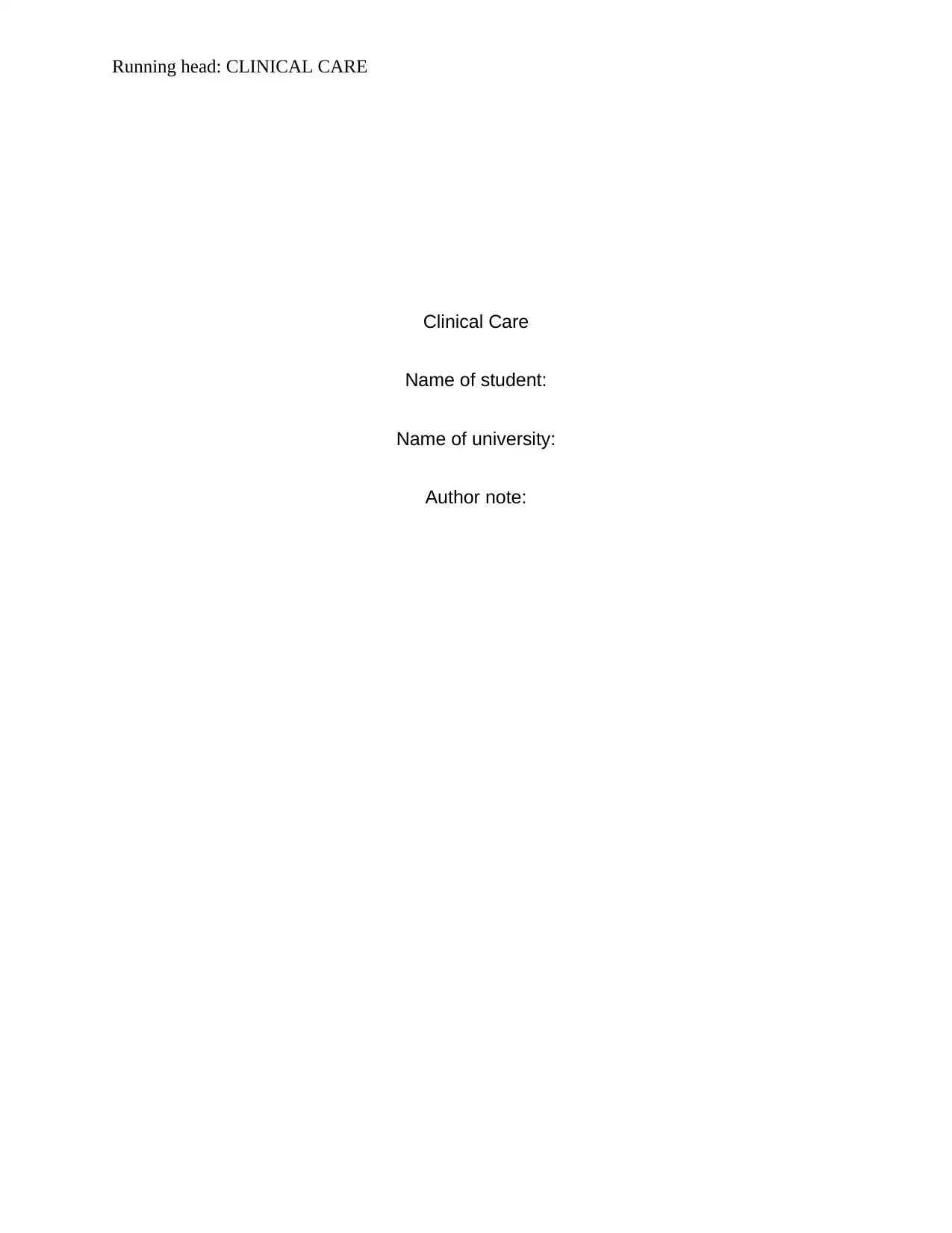
Running head: CLINICAL CARE
Clinical Care
Name of student:
Name of university:
Author note:
Clinical Care
Name of student:
Name of university:
Author note:
Secure Best Marks with AI Grader
Need help grading? Try our AI Grader for instant feedback on your assignments.
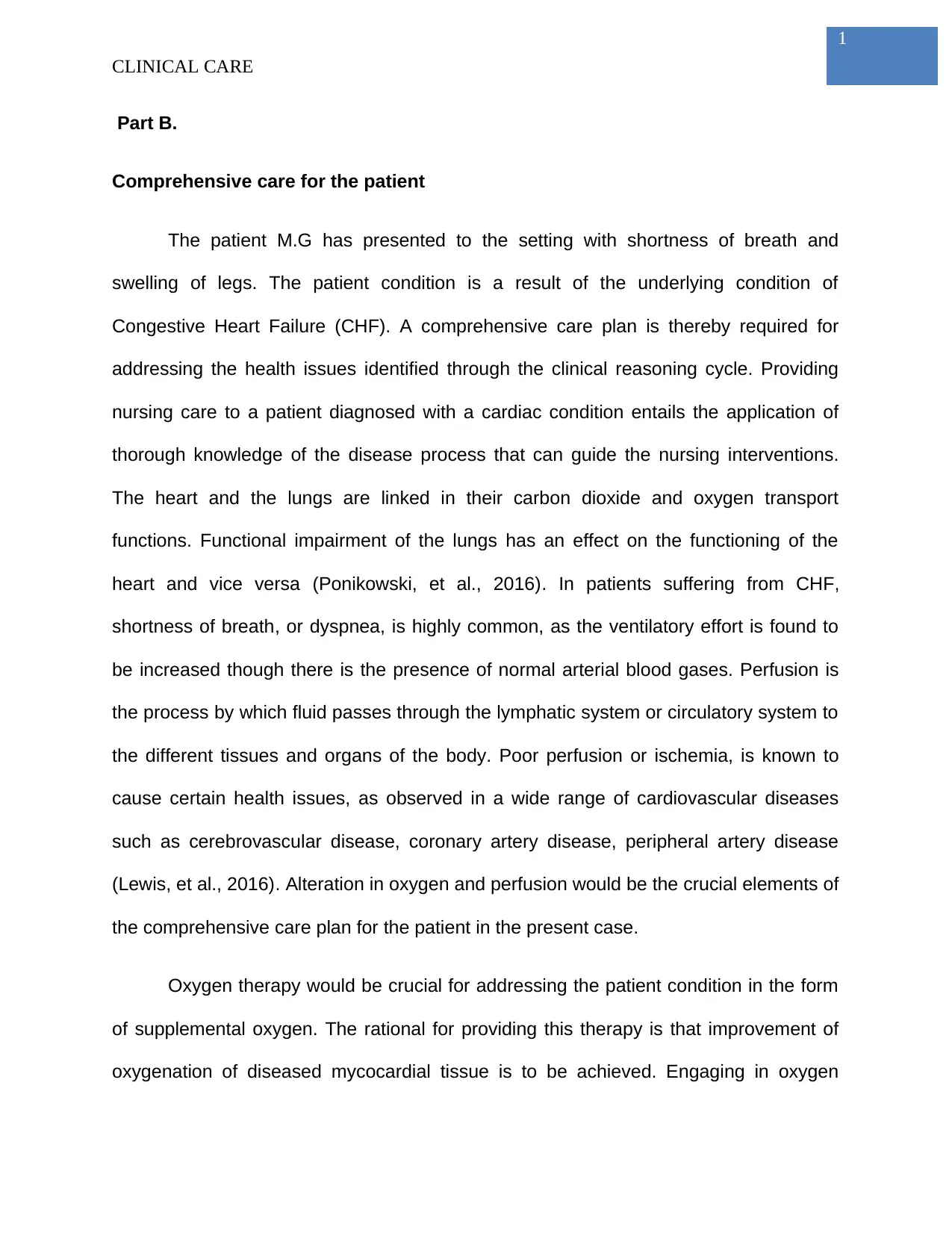
1
CLINICAL CARE
Part B.
Comprehensive care for the patient
The patient M.G has presented to the setting with shortness of breath and
swelling of legs. The patient condition is a result of the underlying condition of
Congestive Heart Failure (CHF). A comprehensive care plan is thereby required for
addressing the health issues identified through the clinical reasoning cycle. Providing
nursing care to a patient diagnosed with a cardiac condition entails the application of
thorough knowledge of the disease process that can guide the nursing interventions.
The heart and the lungs are linked in their carbon dioxide and oxygen transport
functions. Functional impairment of the lungs has an effect on the functioning of the
heart and vice versa (Ponikowski, et al., 2016). In patients suffering from CHF,
shortness of breath, or dyspnea, is highly common, as the ventilatory effort is found to
be increased though there is the presence of normal arterial blood gases. Perfusion is
the process by which fluid passes through the lymphatic system or circulatory system to
the different tissues and organs of the body. Poor perfusion or ischemia, is known to
cause certain health issues, as observed in a wide range of cardiovascular diseases
such as cerebrovascular disease, coronary artery disease, peripheral artery disease
(Lewis, et al., 2016). Alteration in oxygen and perfusion would be the crucial elements of
the comprehensive care plan for the patient in the present case.
Oxygen therapy would be crucial for addressing the patient condition in the form
of supplemental oxygen. The rational for providing this therapy is that improvement of
oxygenation of diseased mycocardial tissue is to be achieved. Engaging in oxygen
CLINICAL CARE
Part B.
Comprehensive care for the patient
The patient M.G has presented to the setting with shortness of breath and
swelling of legs. The patient condition is a result of the underlying condition of
Congestive Heart Failure (CHF). A comprehensive care plan is thereby required for
addressing the health issues identified through the clinical reasoning cycle. Providing
nursing care to a patient diagnosed with a cardiac condition entails the application of
thorough knowledge of the disease process that can guide the nursing interventions.
The heart and the lungs are linked in their carbon dioxide and oxygen transport
functions. Functional impairment of the lungs has an effect on the functioning of the
heart and vice versa (Ponikowski, et al., 2016). In patients suffering from CHF,
shortness of breath, or dyspnea, is highly common, as the ventilatory effort is found to
be increased though there is the presence of normal arterial blood gases. Perfusion is
the process by which fluid passes through the lymphatic system or circulatory system to
the different tissues and organs of the body. Poor perfusion or ischemia, is known to
cause certain health issues, as observed in a wide range of cardiovascular diseases
such as cerebrovascular disease, coronary artery disease, peripheral artery disease
(Lewis, et al., 2016). Alteration in oxygen and perfusion would be the crucial elements of
the comprehensive care plan for the patient in the present case.
Oxygen therapy would be crucial for addressing the patient condition in the form
of supplemental oxygen. The rational for providing this therapy is that improvement of
oxygenation of diseased mycocardial tissue is to be achieved. Engaging in oxygen
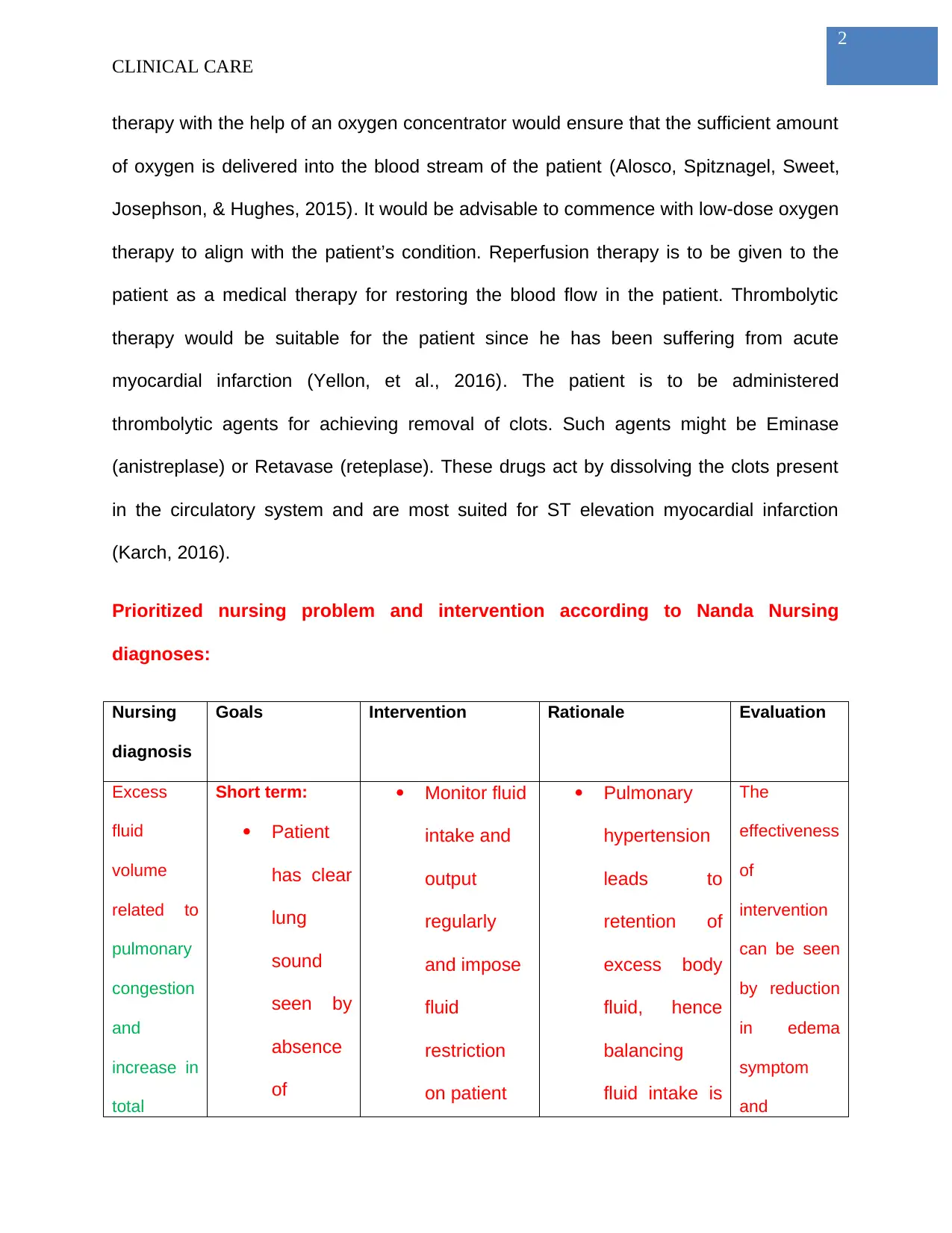
2
CLINICAL CARE
therapy with the help of an oxygen concentrator would ensure that the sufficient amount
of oxygen is delivered into the blood stream of the patient (Alosco, Spitznagel, Sweet,
Josephson, & Hughes, 2015). It would be advisable to commence with low-dose oxygen
therapy to align with the patient’s condition. Reperfusion therapy is to be given to the
patient as a medical therapy for restoring the blood flow in the patient. Thrombolytic
therapy would be suitable for the patient since he has been suffering from acute
myocardial infarction (Yellon, et al., 2016). The patient is to be administered
thrombolytic agents for achieving removal of clots. Such agents might be Eminase
(anistreplase) or Retavase (reteplase). These drugs act by dissolving the clots present
in the circulatory system and are most suited for ST elevation myocardial infarction
(Karch, 2016).
Prioritized nursing problem and intervention according to Nanda Nursing
diagnoses:
Nursing
diagnosis
Goals Intervention Rationale Evaluation
Excess
fluid
volume
related to
pulmonary
congestion
and
increase in
total
Short term:
Patient
has clear
lung
sound
seen by
absence
of
Monitor fluid
intake and
output
regularly
and impose
fluid
restriction
on patient
Pulmonary
hypertension
leads to
retention of
excess body
fluid, hence
balancing
fluid intake is
The
effectiveness
of
intervention
can be seen
by reduction
in edema
symptom
and
CLINICAL CARE
therapy with the help of an oxygen concentrator would ensure that the sufficient amount
of oxygen is delivered into the blood stream of the patient (Alosco, Spitznagel, Sweet,
Josephson, & Hughes, 2015). It would be advisable to commence with low-dose oxygen
therapy to align with the patient’s condition. Reperfusion therapy is to be given to the
patient as a medical therapy for restoring the blood flow in the patient. Thrombolytic
therapy would be suitable for the patient since he has been suffering from acute
myocardial infarction (Yellon, et al., 2016). The patient is to be administered
thrombolytic agents for achieving removal of clots. Such agents might be Eminase
(anistreplase) or Retavase (reteplase). These drugs act by dissolving the clots present
in the circulatory system and are most suited for ST elevation myocardial infarction
(Karch, 2016).
Prioritized nursing problem and intervention according to Nanda Nursing
diagnoses:
Nursing
diagnosis
Goals Intervention Rationale Evaluation
Excess
fluid
volume
related to
pulmonary
congestion
and
increase in
total
Short term:
Patient
has clear
lung
sound
seen by
absence
of
Monitor fluid
intake and
output
regularly
and impose
fluid
restriction
on patient
Pulmonary
hypertension
leads to
retention of
excess body
fluid, hence
balancing
fluid intake is
The
effectiveness
of
intervention
can be seen
by reduction
in edema
symptom
and
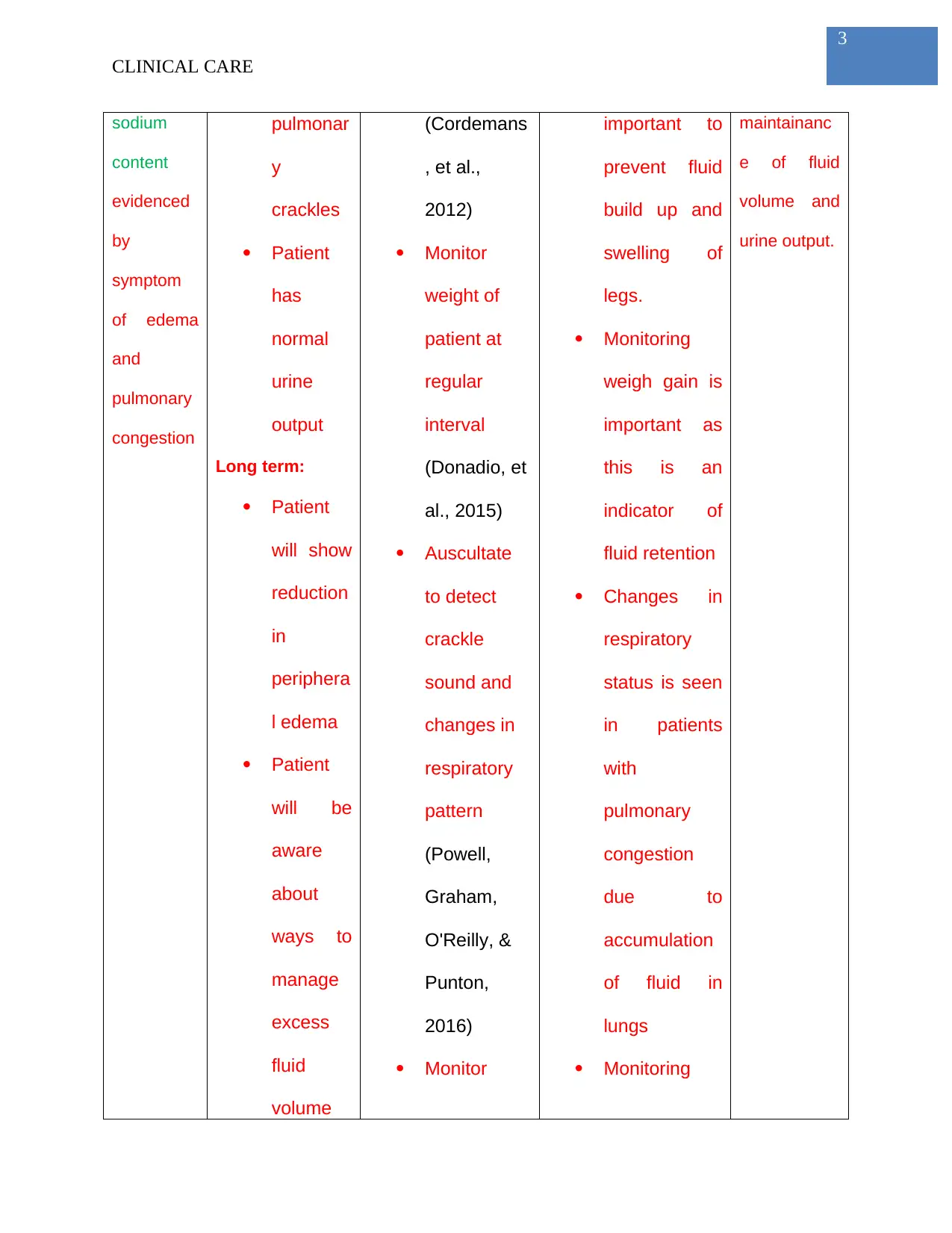
3
CLINICAL CARE
sodium
content
evidenced
by
symptom
of edema
and
pulmonary
congestion
pulmonar
y
crackles
Patient
has
normal
urine
output
Long term:
Patient
will show
reduction
in
periphera
l edema
Patient
will be
aware
about
ways to
manage
excess
fluid
volume
(Cordemans
, et al.,
2012)
Monitor
weight of
patient at
regular
interval
(Donadio, et
al., 2015)
Auscultate
to detect
crackle
sound and
changes in
respiratory
pattern
(Powell,
Graham,
O'Reilly, &
Punton,
2016)
Monitor
important to
prevent fluid
build up and
swelling of
legs.
Monitoring
weigh gain is
important as
this is an
indicator of
fluid retention
Changes in
respiratory
status is seen
in patients
with
pulmonary
congestion
due to
accumulation
of fluid in
lungs
Monitoring
maintainanc
e of fluid
volume and
urine output.
CLINICAL CARE
sodium
content
evidenced
by
symptom
of edema
and
pulmonary
congestion
pulmonar
y
crackles
Patient
has
normal
urine
output
Long term:
Patient
will show
reduction
in
periphera
l edema
Patient
will be
aware
about
ways to
manage
excess
fluid
volume
(Cordemans
, et al.,
2012)
Monitor
weight of
patient at
regular
interval
(Donadio, et
al., 2015)
Auscultate
to detect
crackle
sound and
changes in
respiratory
pattern
(Powell,
Graham,
O'Reilly, &
Punton,
2016)
Monitor
important to
prevent fluid
build up and
swelling of
legs.
Monitoring
weigh gain is
important as
this is an
indicator of
fluid retention
Changes in
respiratory
status is seen
in patients
with
pulmonary
congestion
due to
accumulation
of fluid in
lungs
Monitoring
maintainanc
e of fluid
volume and
urine output.
Secure Best Marks with AI Grader
Need help grading? Try our AI Grader for instant feedback on your assignments.
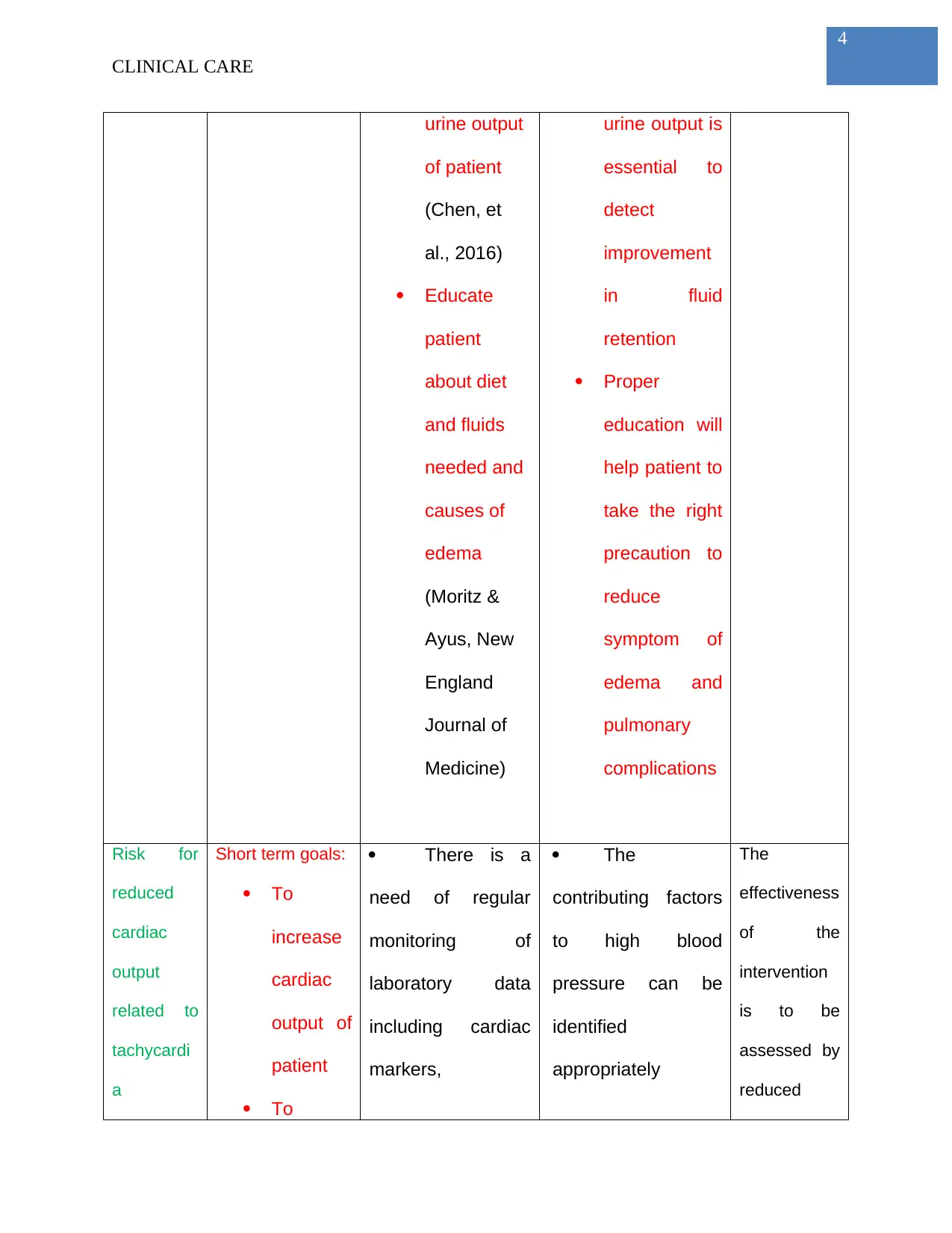
4
CLINICAL CARE
urine output
of patient
(Chen, et
al., 2016)
Educate
patient
about diet
and fluids
needed and
causes of
edema
(Moritz &
Ayus, New
England
Journal of
Medicine)
urine output is
essential to
detect
improvement
in fluid
retention
Proper
education will
help patient to
take the right
precaution to
reduce
symptom of
edema and
pulmonary
complications
Risk for
reduced
cardiac
output
related to
tachycardi
a
Short term goals:
To
increase
cardiac
output of
patient
To
There is a
need of regular
monitoring of
laboratory data
including cardiac
markers,
The
contributing factors
to high blood
pressure can be
identified
appropriately
The
effectiveness
of the
intervention
is to be
assessed by
reduced
CLINICAL CARE
urine output
of patient
(Chen, et
al., 2016)
Educate
patient
about diet
and fluids
needed and
causes of
edema
(Moritz &
Ayus, New
England
Journal of
Medicine)
urine output is
essential to
detect
improvement
in fluid
retention
Proper
education will
help patient to
take the right
precaution to
reduce
symptom of
edema and
pulmonary
complications
Risk for
reduced
cardiac
output
related to
tachycardi
a
Short term goals:
To
increase
cardiac
output of
patient
To
There is a
need of regular
monitoring of
laboratory data
including cardiac
markers,
The
contributing factors
to high blood
pressure can be
identified
appropriately
The
effectiveness
of the
intervention
is to be
assessed by
reduced
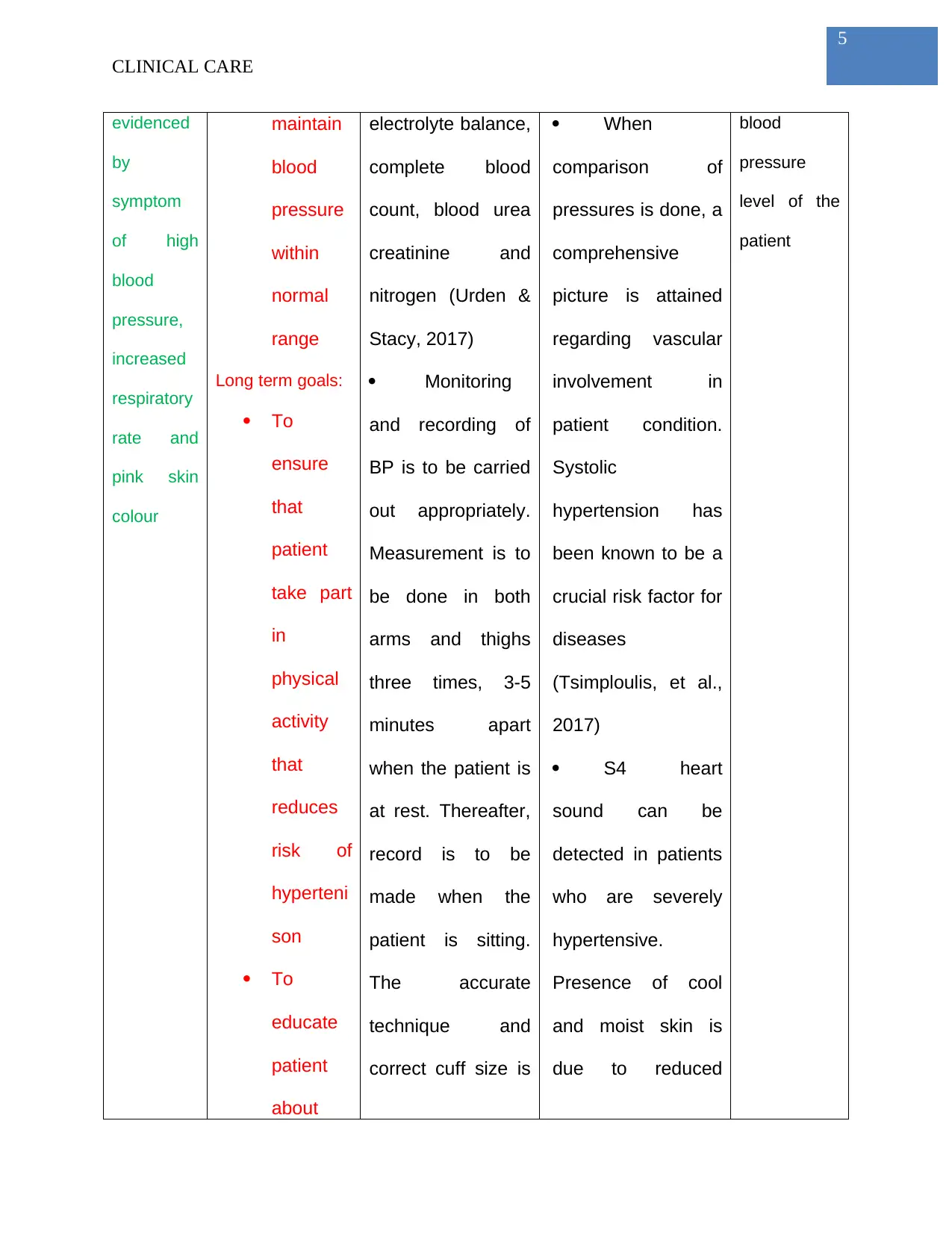
5
CLINICAL CARE
evidenced
by
symptom
of high
blood
pressure,
increased
respiratory
rate and
pink skin
colour
maintain
blood
pressure
within
normal
range
Long term goals:
To
ensure
that
patient
take part
in
physical
activity
that
reduces
risk of
hyperteni
son
To
educate
patient
about
electrolyte balance,
complete blood
count, blood urea
creatinine and
nitrogen (Urden &
Stacy, 2017)
Monitoring
and recording of
BP is to be carried
out appropriately.
Measurement is to
be done in both
arms and thighs
three times, 3-5
minutes apart
when the patient is
at rest. Thereafter,
record is to be
made when the
patient is sitting.
The accurate
technique and
correct cuff size is
When
comparison of
pressures is done, a
comprehensive
picture is attained
regarding vascular
involvement in
patient condition.
Systolic
hypertension has
been known to be a
crucial risk factor for
diseases
(Tsimploulis, et al.,
2017)
S4 heart
sound can be
detected in patients
who are severely
hypertensive.
Presence of cool
and moist skin is
due to reduced
blood
pressure
level of the
patient
CLINICAL CARE
evidenced
by
symptom
of high
blood
pressure,
increased
respiratory
rate and
pink skin
colour
maintain
blood
pressure
within
normal
range
Long term goals:
To
ensure
that
patient
take part
in
physical
activity
that
reduces
risk of
hyperteni
son
To
educate
patient
about
electrolyte balance,
complete blood
count, blood urea
creatinine and
nitrogen (Urden &
Stacy, 2017)
Monitoring
and recording of
BP is to be carried
out appropriately.
Measurement is to
be done in both
arms and thighs
three times, 3-5
minutes apart
when the patient is
at rest. Thereafter,
record is to be
made when the
patient is sitting.
The accurate
technique and
correct cuff size is
When
comparison of
pressures is done, a
comprehensive
picture is attained
regarding vascular
involvement in
patient condition.
Systolic
hypertension has
been known to be a
crucial risk factor for
diseases
(Tsimploulis, et al.,
2017)
S4 heart
sound can be
detected in patients
who are severely
hypertensive.
Presence of cool
and moist skin is
due to reduced
blood
pressure
level of the
patient
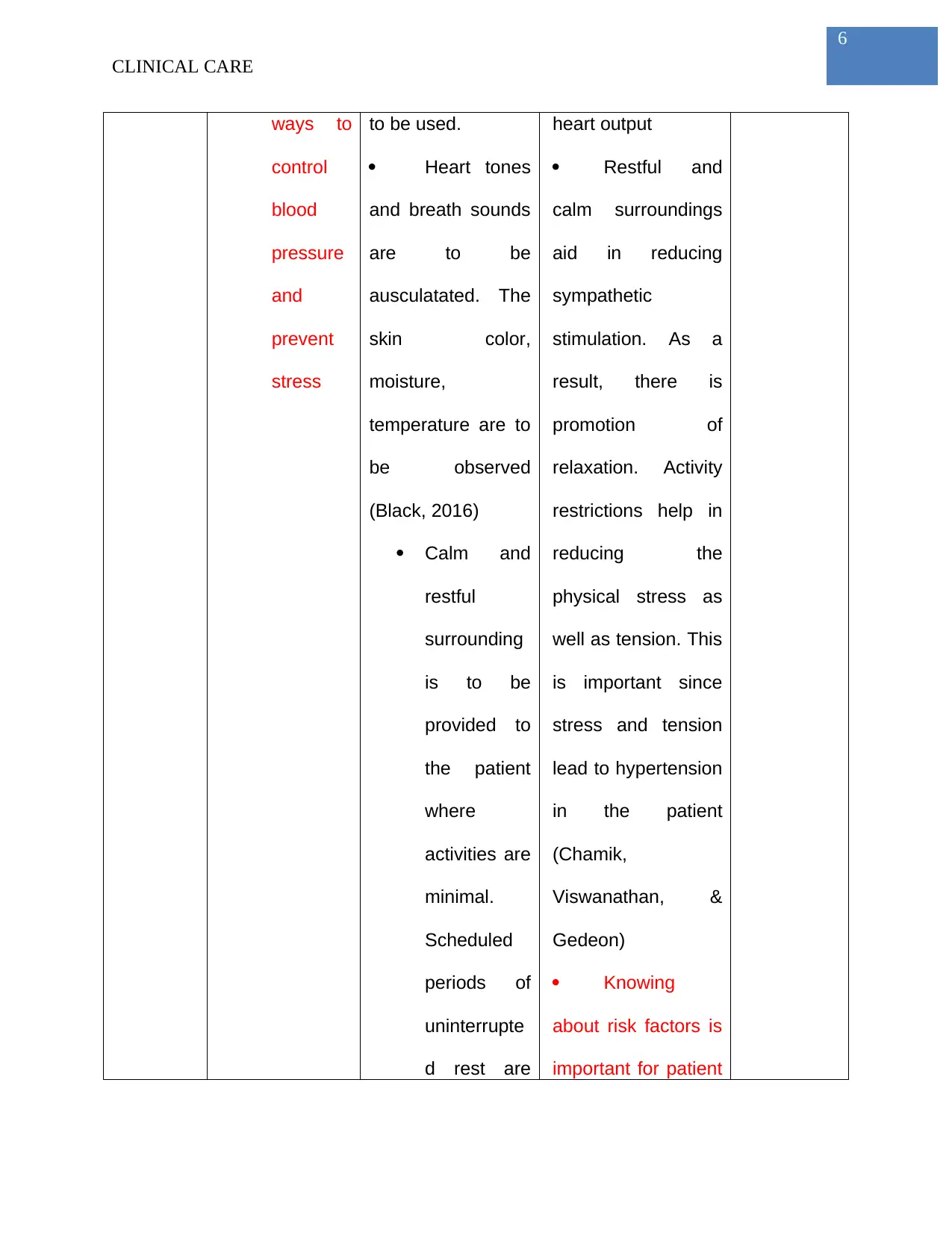
6
CLINICAL CARE
ways to
control
blood
pressure
and
prevent
stress
to be used.
Heart tones
and breath sounds
are to be
ausculatated. The
skin color,
moisture,
temperature are to
be observed
(Black, 2016)
Calm and
restful
surrounding
is to be
provided to
the patient
where
activities are
minimal.
Scheduled
periods of
uninterrupte
d rest are
heart output
Restful and
calm surroundings
aid in reducing
sympathetic
stimulation. As a
result, there is
promotion of
relaxation. Activity
restrictions help in
reducing the
physical stress as
well as tension. This
is important since
stress and tension
lead to hypertension
in the patient
(Chamik,
Viswanathan, &
Gedeon)
Knowing
about risk factors is
important for patient
CLINICAL CARE
ways to
control
blood
pressure
and
prevent
stress
to be used.
Heart tones
and breath sounds
are to be
ausculatated. The
skin color,
moisture,
temperature are to
be observed
(Black, 2016)
Calm and
restful
surrounding
is to be
provided to
the patient
where
activities are
minimal.
Scheduled
periods of
uninterrupte
d rest are
heart output
Restful and
calm surroundings
aid in reducing
sympathetic
stimulation. As a
result, there is
promotion of
relaxation. Activity
restrictions help in
reducing the
physical stress as
well as tension. This
is important since
stress and tension
lead to hypertension
in the patient
(Chamik,
Viswanathan, &
Gedeon)
Knowing
about risk factors is
important for patient
Paraphrase This Document
Need a fresh take? Get an instant paraphrase of this document with our AI Paraphraser
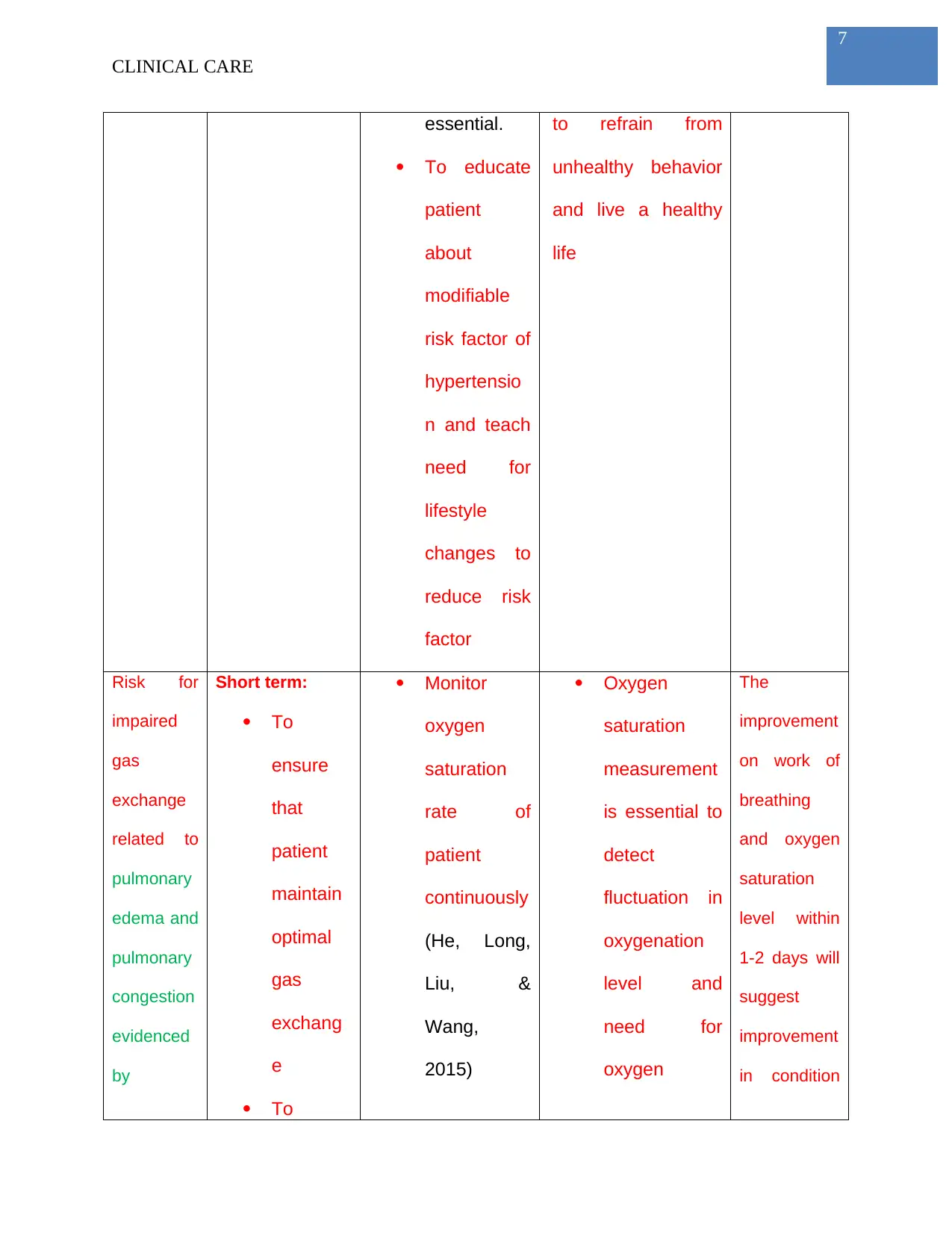
7
CLINICAL CARE
essential.
To educate
patient
about
modifiable
risk factor of
hypertensio
n and teach
need for
lifestyle
changes to
reduce risk
factor
to refrain from
unhealthy behavior
and live a healthy
life
Risk for
impaired
gas
exchange
related to
pulmonary
edema and
pulmonary
congestion
evidenced
by
Short term:
To
ensure
that
patient
maintain
optimal
gas
exchang
e
To
Monitor
oxygen
saturation
rate of
patient
continuously
(He, Long,
Liu, &
Wang,
2015)
Oxygen
saturation
measurement
is essential to
detect
fluctuation in
oxygenation
level and
need for
oxygen
The
improvement
on work of
breathing
and oxygen
saturation
level within
1-2 days will
suggest
improvement
in condition
CLINICAL CARE
essential.
To educate
patient
about
modifiable
risk factor of
hypertensio
n and teach
need for
lifestyle
changes to
reduce risk
factor
to refrain from
unhealthy behavior
and live a healthy
life
Risk for
impaired
gas
exchange
related to
pulmonary
edema and
pulmonary
congestion
evidenced
by
Short term:
To
ensure
that
patient
maintain
optimal
gas
exchang
e
To
Monitor
oxygen
saturation
rate of
patient
continuously
(He, Long,
Liu, &
Wang,
2015)
Oxygen
saturation
measurement
is essential to
detect
fluctuation in
oxygenation
level and
need for
oxygen
The
improvement
on work of
breathing
and oxygen
saturation
level within
1-2 days will
suggest
improvement
in condition
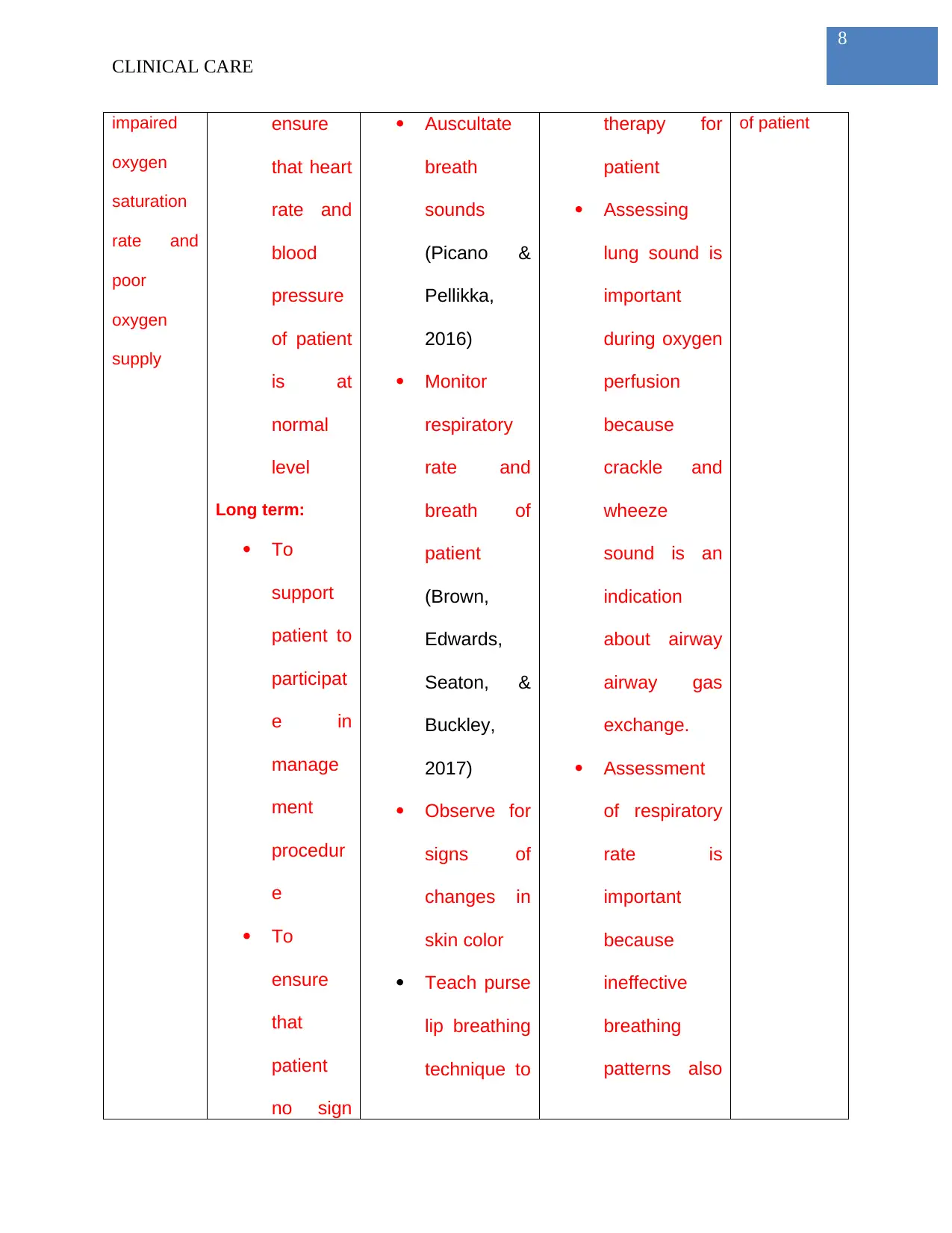
8
CLINICAL CARE
impaired
oxygen
saturation
rate and
poor
oxygen
supply
ensure
that heart
rate and
blood
pressure
of patient
is at
normal
level
Long term:
To
support
patient to
participat
e in
manage
ment
procedur
e
To
ensure
that
patient
no sign
Auscultate
breath
sounds
(Picano &
Pellikka,
2016)
Monitor
respiratory
rate and
breath of
patient
(Brown,
Edwards,
Seaton, &
Buckley,
2017)
Observe for
signs of
changes in
skin color
Teach purse
lip breathing
technique to
therapy for
patient
Assessing
lung sound is
important
during oxygen
perfusion
because
crackle and
wheeze
sound is an
indication
about airway
airway gas
exchange.
Assessment
of respiratory
rate is
important
because
ineffective
breathing
patterns also
of patient
CLINICAL CARE
impaired
oxygen
saturation
rate and
poor
oxygen
supply
ensure
that heart
rate and
blood
pressure
of patient
is at
normal
level
Long term:
To
support
patient to
participat
e in
manage
ment
procedur
e
To
ensure
that
patient
no sign
Auscultate
breath
sounds
(Picano &
Pellikka,
2016)
Monitor
respiratory
rate and
breath of
patient
(Brown,
Edwards,
Seaton, &
Buckley,
2017)
Observe for
signs of
changes in
skin color
Teach purse
lip breathing
technique to
therapy for
patient
Assessing
lung sound is
important
during oxygen
perfusion
because
crackle and
wheeze
sound is an
indication
about airway
airway gas
exchange.
Assessment
of respiratory
rate is
important
because
ineffective
breathing
patterns also
of patient
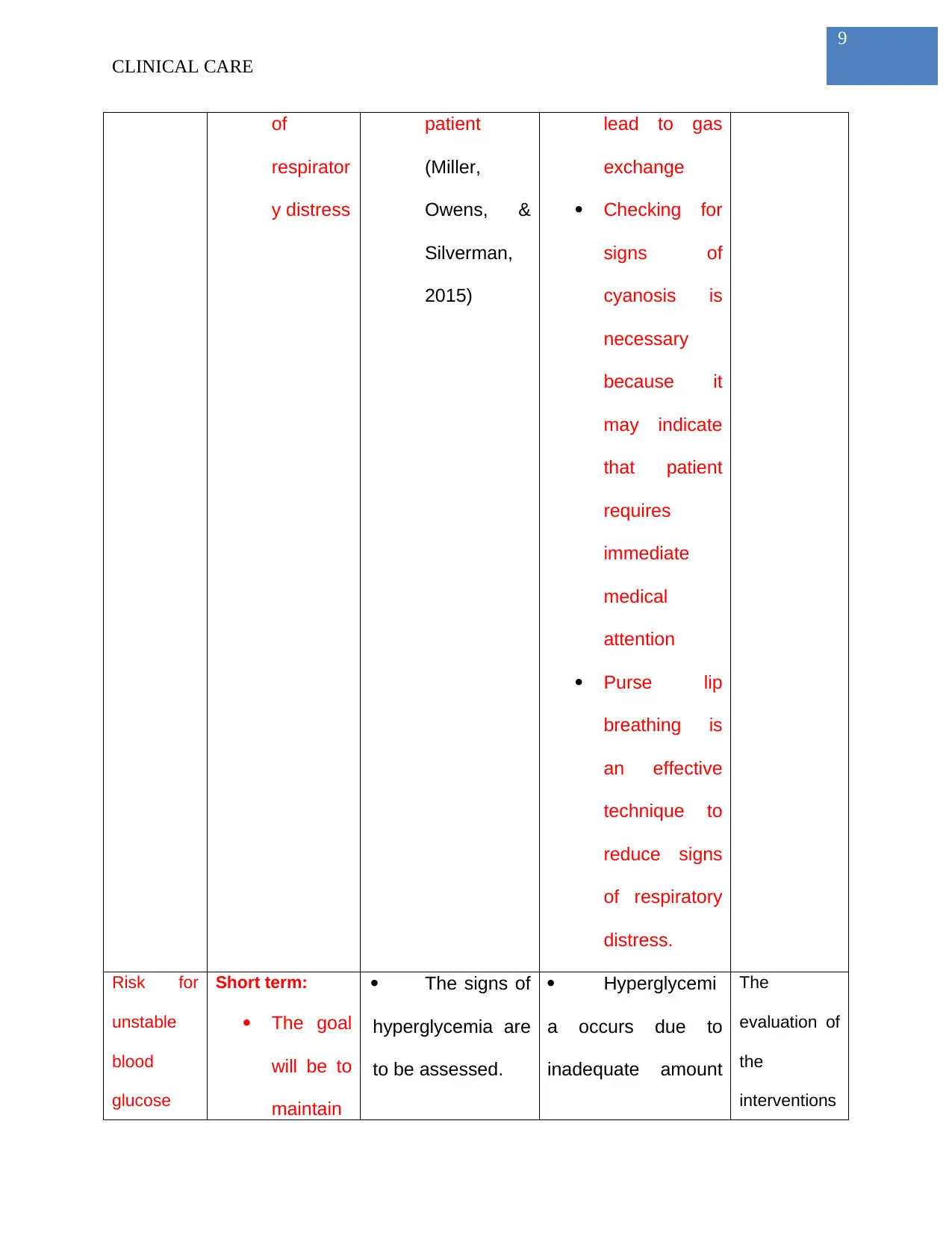
9
CLINICAL CARE
of
respirator
y distress
patient
(Miller,
Owens, &
Silverman,
2015)
lead to gas
exchange
Checking for
signs of
cyanosis is
necessary
because it
may indicate
that patient
requires
immediate
medical
attention
Purse lip
breathing is
an effective
technique to
reduce signs
of respiratory
distress.
Risk for
unstable
blood
glucose
Short term:
The goal
will be to
maintain
The signs of
hyperglycemia are
to be assessed.
Hyperglycemi
a occurs due to
inadequate amount
The
evaluation of
the
interventions
CLINICAL CARE
of
respirator
y distress
patient
(Miller,
Owens, &
Silverman,
2015)
lead to gas
exchange
Checking for
signs of
cyanosis is
necessary
because it
may indicate
that patient
requires
immediate
medical
attention
Purse lip
breathing is
an effective
technique to
reduce signs
of respiratory
distress.
Risk for
unstable
blood
glucose
Short term:
The goal
will be to
maintain
The signs of
hyperglycemia are
to be assessed.
Hyperglycemi
a occurs due to
inadequate amount
The
evaluation of
the
interventions
Secure Best Marks with AI Grader
Need help grading? Try our AI Grader for instant feedback on your assignments.
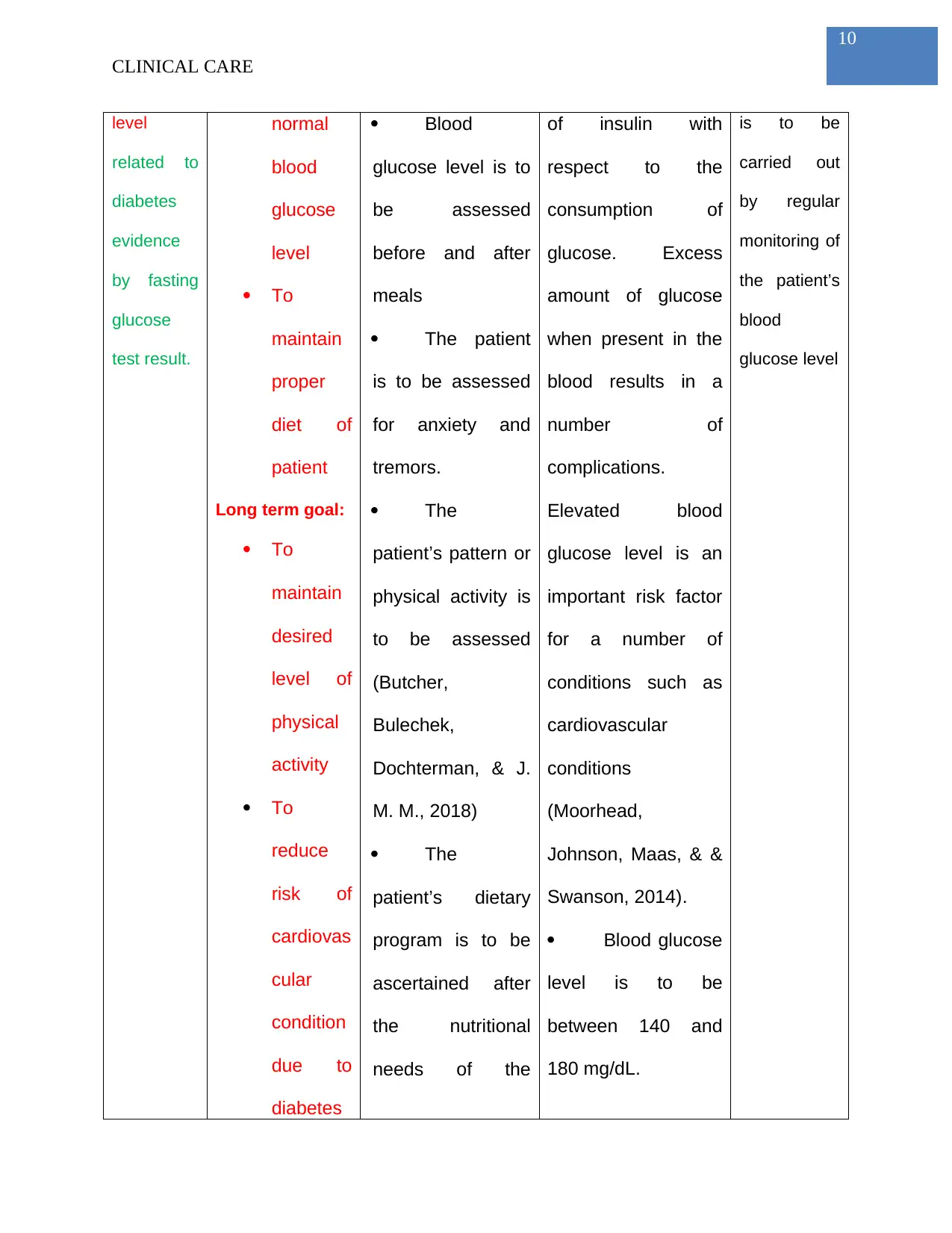
10
CLINICAL CARE
level
related to
diabetes
evidence
by fasting
glucose
test result.
normal
blood
glucose
level
To
maintain
proper
diet of
patient
Long term goal:
To
maintain
desired
level of
physical
activity
To
reduce
risk of
cardiovas
cular
condition
due to
diabetes
Blood
glucose level is to
be assessed
before and after
meals
The patient
is to be assessed
for anxiety and
tremors.
The
patient’s pattern or
physical activity is
to be assessed
(Butcher,
Bulechek,
Dochterman, & J.
M. M., 2018)
The
patient’s dietary
program is to be
ascertained after
the nutritional
needs of the
of insulin with
respect to the
consumption of
glucose. Excess
amount of glucose
when present in the
blood results in a
number of
complications.
Elevated blood
glucose level is an
important risk factor
for a number of
conditions such as
cardiovascular
conditions
(Moorhead,
Johnson, Maas, & &
Swanson, 2014).
Blood glucose
level is to be
between 140 and
180 mg/dL.
is to be
carried out
by regular
monitoring of
the patient’s
blood
glucose level
CLINICAL CARE
level
related to
diabetes
evidence
by fasting
glucose
test result.
normal
blood
glucose
level
To
maintain
proper
diet of
patient
Long term goal:
To
maintain
desired
level of
physical
activity
To
reduce
risk of
cardiovas
cular
condition
due to
diabetes
Blood
glucose level is to
be assessed
before and after
meals
The patient
is to be assessed
for anxiety and
tremors.
The
patient’s pattern or
physical activity is
to be assessed
(Butcher,
Bulechek,
Dochterman, & J.
M. M., 2018)
The
patient’s dietary
program is to be
ascertained after
the nutritional
needs of the
of insulin with
respect to the
consumption of
glucose. Excess
amount of glucose
when present in the
blood results in a
number of
complications.
Elevated blood
glucose level is an
important risk factor
for a number of
conditions such as
cardiovascular
conditions
(Moorhead,
Johnson, Maas, & &
Swanson, 2014).
Blood glucose
level is to be
between 140 and
180 mg/dL.
is to be
carried out
by regular
monitoring of
the patient’s
blood
glucose level
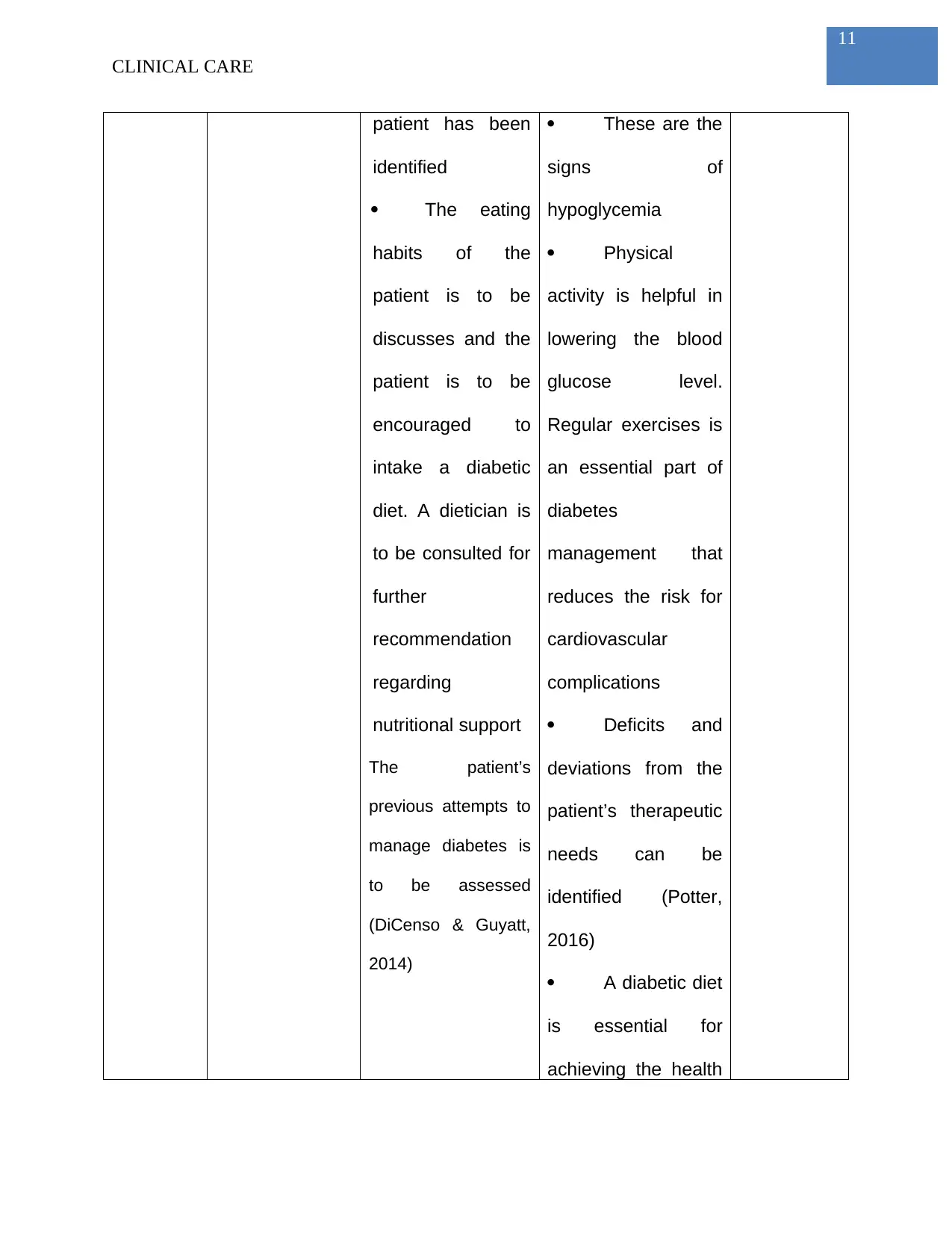
11
CLINICAL CARE
patient has been
identified
The eating
habits of the
patient is to be
discusses and the
patient is to be
encouraged to
intake a diabetic
diet. A dietician is
to be consulted for
further
recommendation
regarding
nutritional support
The patient’s
previous attempts to
manage diabetes is
to be assessed
(DiCenso & Guyatt,
2014)
These are the
signs of
hypoglycemia
Physical
activity is helpful in
lowering the blood
glucose level.
Regular exercises is
an essential part of
diabetes
management that
reduces the risk for
cardiovascular
complications
Deficits and
deviations from the
patient’s therapeutic
needs can be
identified (Potter,
2016)
A diabetic diet
is essential for
achieving the health
CLINICAL CARE
patient has been
identified
The eating
habits of the
patient is to be
discusses and the
patient is to be
encouraged to
intake a diabetic
diet. A dietician is
to be consulted for
further
recommendation
regarding
nutritional support
The patient’s
previous attempts to
manage diabetes is
to be assessed
(DiCenso & Guyatt,
2014)
These are the
signs of
hypoglycemia
Physical
activity is helpful in
lowering the blood
glucose level.
Regular exercises is
an essential part of
diabetes
management that
reduces the risk for
cardiovascular
complications
Deficits and
deviations from the
patient’s therapeutic
needs can be
identified (Potter,
2016)
A diabetic diet
is essential for
achieving the health
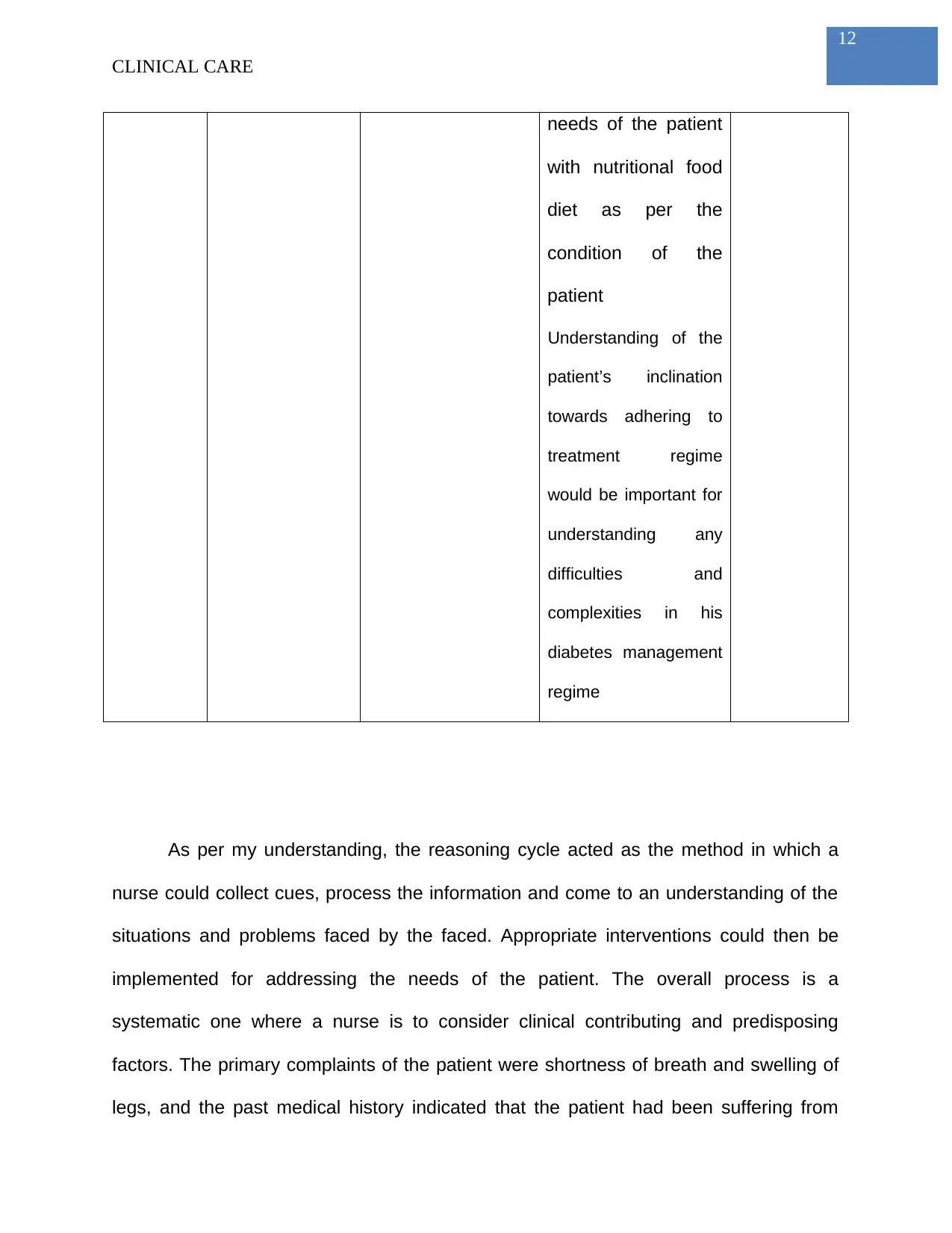
12
CLINICAL CARE
needs of the patient
with nutritional food
diet as per the
condition of the
patient
Understanding of the
patient’s inclination
towards adhering to
treatment regime
would be important for
understanding any
difficulties and
complexities in his
diabetes management
regime
As per my understanding, the reasoning cycle acted as the method in which a
nurse could collect cues, process the information and come to an understanding of the
situations and problems faced by the faced. Appropriate interventions could then be
implemented for addressing the needs of the patient. The overall process is a
systematic one where a nurse is to consider clinical contributing and predisposing
factors. The primary complaints of the patient were shortness of breath and swelling of
legs, and the past medical history indicated that the patient had been suffering from
CLINICAL CARE
needs of the patient
with nutritional food
diet as per the
condition of the
patient
Understanding of the
patient’s inclination
towards adhering to
treatment regime
would be important for
understanding any
difficulties and
complexities in his
diabetes management
regime
As per my understanding, the reasoning cycle acted as the method in which a
nurse could collect cues, process the information and come to an understanding of the
situations and problems faced by the faced. Appropriate interventions could then be
implemented for addressing the needs of the patient. The overall process is a
systematic one where a nurse is to consider clinical contributing and predisposing
factors. The primary complaints of the patient were shortness of breath and swelling of
legs, and the past medical history indicated that the patient had been suffering from
1 out of 13
Related Documents
Your All-in-One AI-Powered Toolkit for Academic Success.
+13062052269
info@desklib.com
Available 24*7 on WhatsApp / Email
![[object Object]](/_next/static/media/star-bottom.7253800d.svg)
Unlock your academic potential
© 2024 | Zucol Services PVT LTD | All rights reserved.





